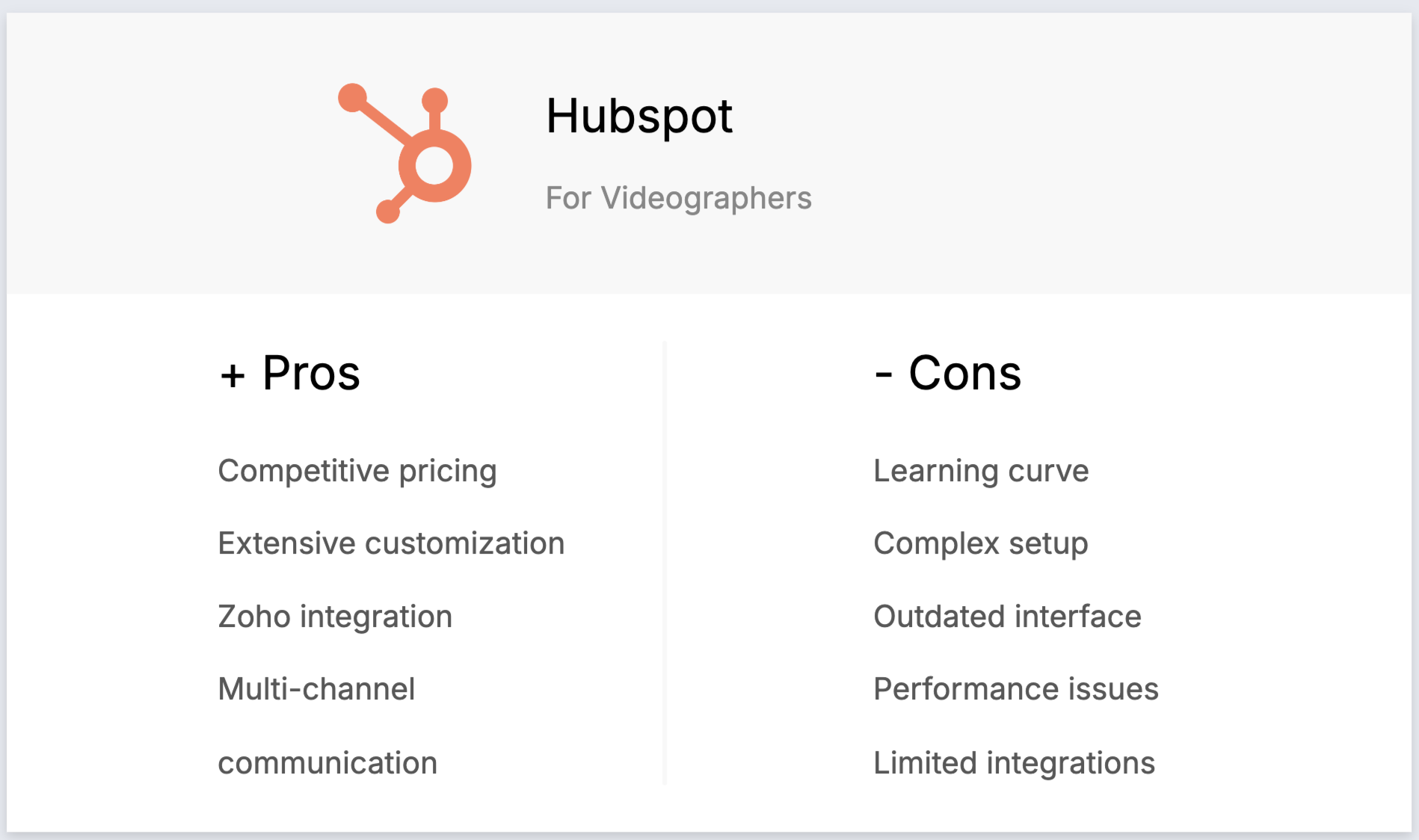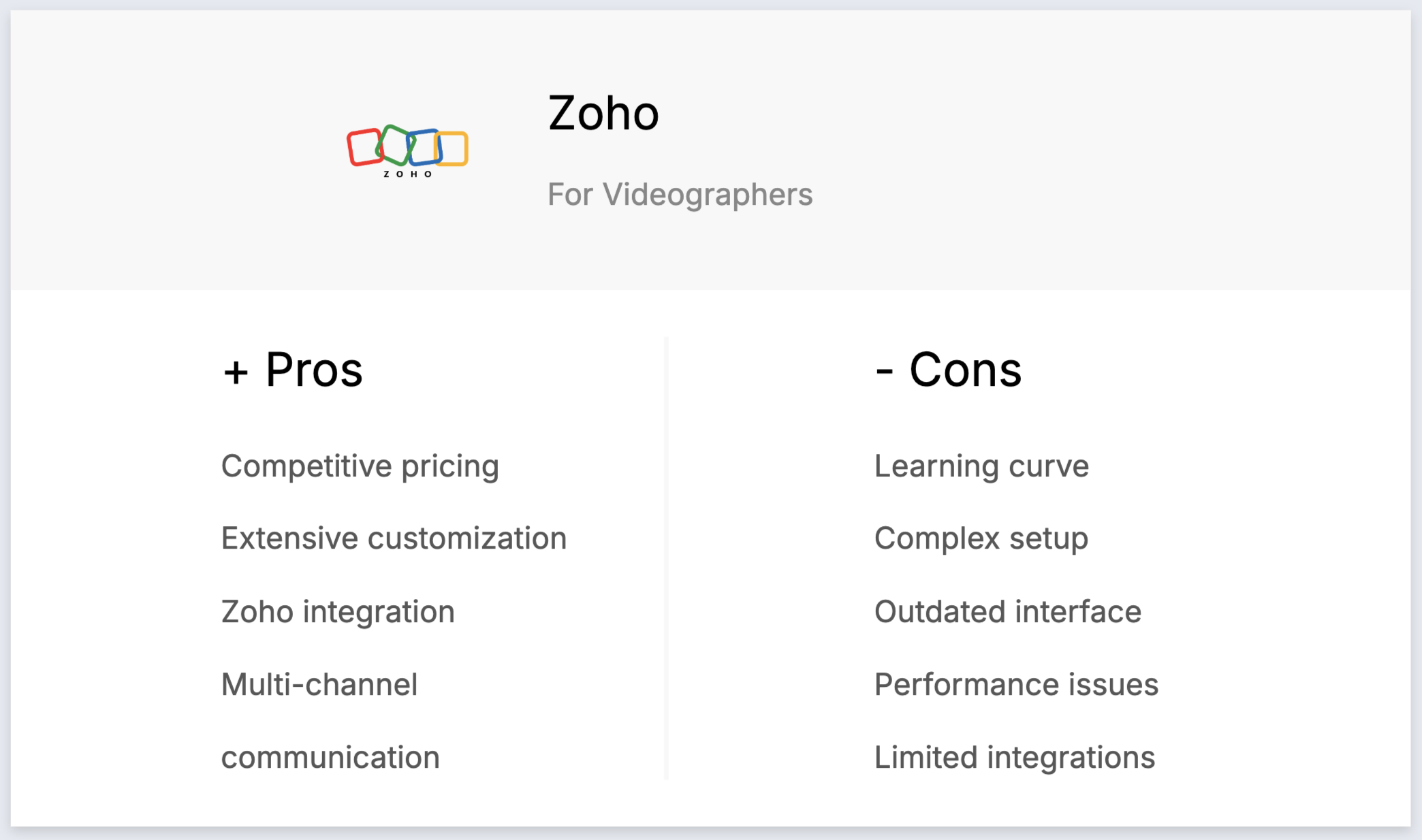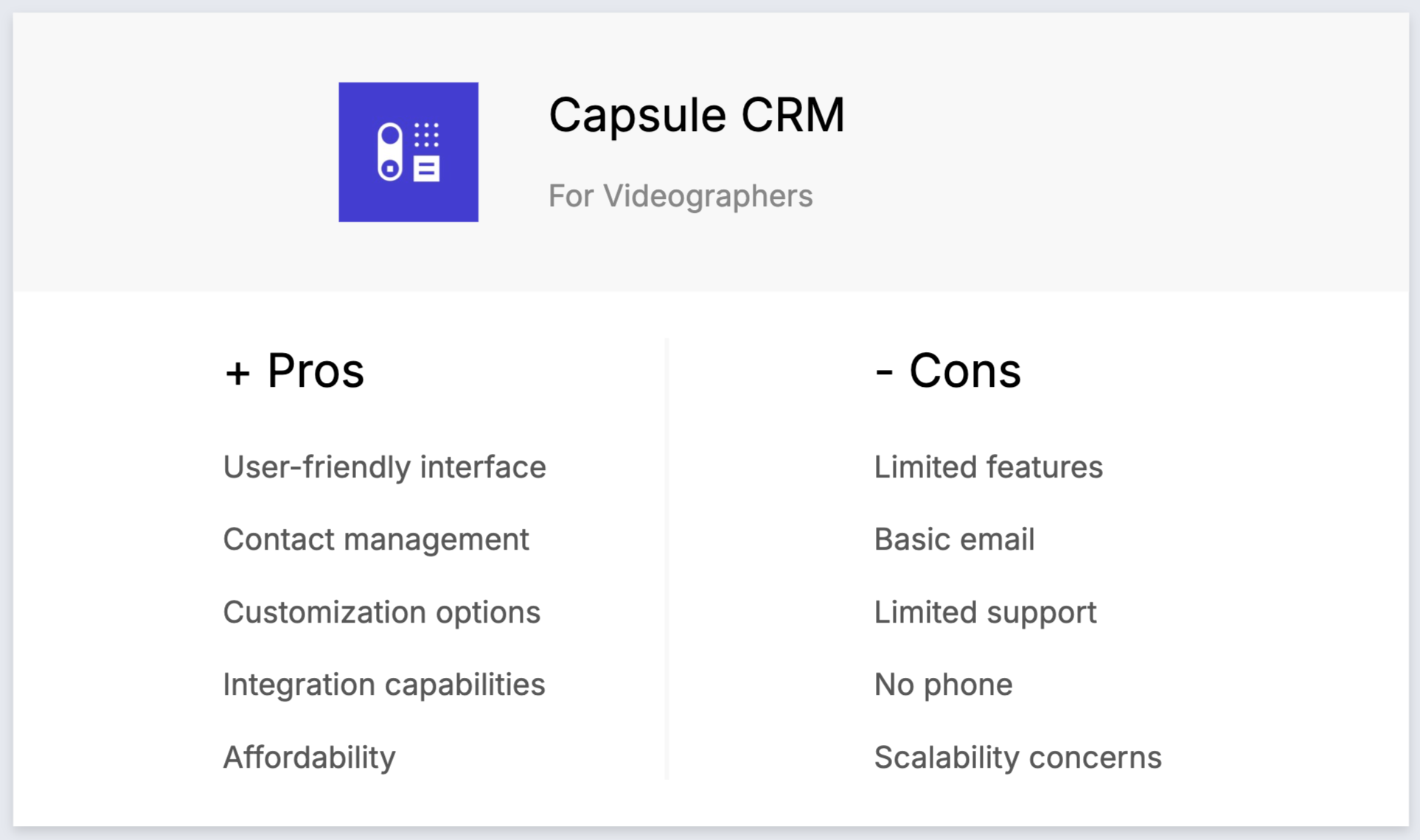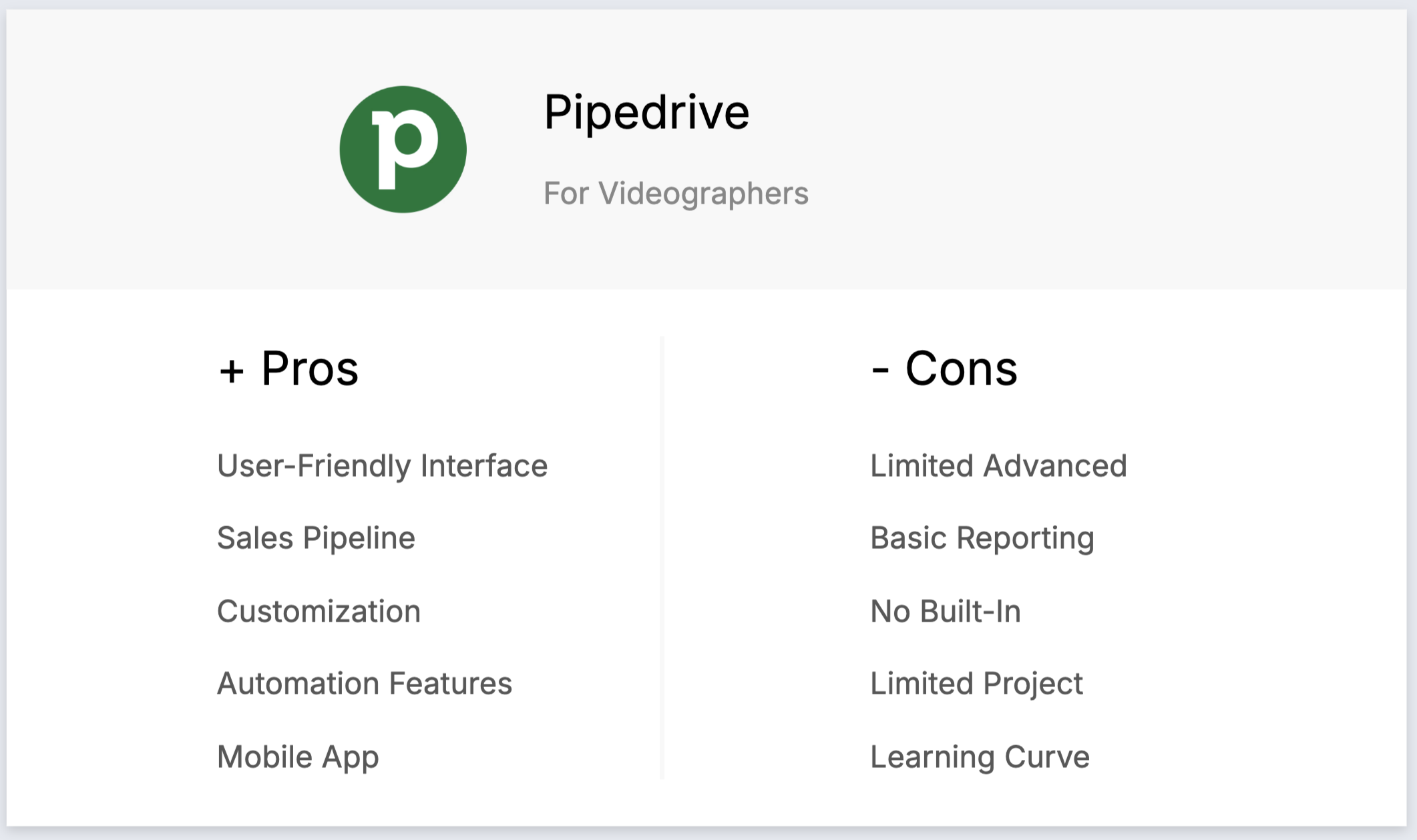Discover folk - the CRM for people-powered businesses
Why CRMs matter for videographers
| Main points |
|---|
|
Filming is only half the job—juggling clients, edits, and follow-ups can quickly become overwhelming.
The best CRM for videographers isn't just about contact management—it's a strategic tool to streamline client communication, automate admin tasks, and keep projects on track.
This guide breaks down the top CRM tools tailored for videographers—so you can spend less time managing chaos and more time behind the camera.
The 5 best CRMs for Videographers
| CRM | Best for | Key Strength | Starting Price |
|---|---|---|---|
| folk | All-in-one contact & workflow management | AI tools + social & LinkedIn sync | $20/user/month |
| HubSpot | Scalable videography teams | Powerful marketing & sales automation | $15/user/month (Starter) |
| Zoho CRM | Custom workflows & automation | Multi-channel communication | $20/user/month |
| Capsule CRM | Small videography businesses | User-friendly UI + custom fields | $21/user/month |
| Pipedrive | Project-focused freelancers & studios | Visual pipelines & sales automation | $24/user/month |
1. folk
folk is a modern CRM platform for managing contacts, workflows, and relationships, offering customizable pipelines, AI-driven tools, and integrations to enhance deal management and prospecting. For videography teams of 20-50 people, folk CRM stands out as the ideal solution, providing seamless collaboration features and automated workflows that keep everyone aligned on client projects and production schedules.

Key features
- Contact enrichment: Automatically enriches contact details by finding emails and LinkedIn URLs, enabling efficient outreach without manual data entry or additional costs for email services.
- LinkedIn integration: Seamlessly import contacts from LinkedIn, track conversations within folk, and use templates for quicker, streamlined communication.
- Email integration: Full email sync, templates, and tracking features, enabling users to manage all communications directly from the CRM.
- AI-powered features: AI tools assist in managing contacts and relationships, automating routine tasks, and suggesting actions to improve productivity.
- Integrations: Beyond Zapier and Make (6,000+ apps), folk offers an open API and native integrations, including WhatsApp, Kaspr, Allo, Salesforge, and PandaDoc.

Pros
- Ease of use: folk is praised for its intuitive interface, making it accessible even to non-technical users with quick onboarding and a minimal learning curve.
- All-in-one: folk streamlines your workflow by allowing you to import contacts from LinkedIn, automatically find their emails, reach out through customizable email sequences, and track interactions in a pipeline, eliminating the need for multiple tools and saving time and money.
- Social media integration: Seamlessly import contacts from LinkedIn, Twitter, Instagram and more to track contact information within folk, and use templates for quicker, streamlined communication.
- Customizability: Get full personalization over custom fields, pipelines, dashboards and workflows.
- Integrations: folk integrates via Zapier/Make (6,000+ apps) and also provides an open API plus native integrations like WhatsApp, Kaspr, Allo, Salesforge, and PandaDoc.
Cons
- Reporting and analytics: folk includes advanced analytics such as pipeline and deal stage reporting, revenue forecasting with weighted probabilities, and performance breakdowns by owner, channel, industry, region, or any custom field.
Price and plans
You can try folk for free with a 14-day free trial. After that, a monthly or annual subscription plan is as follows.
- Standard: $20 per user, per month.
- Premium: $40 per user, per month.
- Custom: Starts from $60 per user, per month.
👉🏼 Try folk now to manage your shoots, edits, and client follow-ups in one simple pipeline
2. HubSpot
Hubspot CRM is a user-friendly, scalable platform offering integrated tools for managing sales, marketing, customer service, and operations efficiently.

Key features
- Marketing Hub: Includes email marketing, ad tracking, landing pages, and lead generation tools. Perfect for videographers looking to attract and convert potential clients.
- Sales Hub: Provides deal tracking, pipeline management, sales automation, and reporting. Essential for managing client projects and closing deals efficiently.
- Service Hub: Offers customer service tools like ticketing, live chat, and knowledge bases. Helps videographers provide excellent post-production support to clients.
- Lead scoring: Prioritize leads with predictive scoring to improve sales efficiency. Ideal for videographers to focus on high-potential clients.
- Operations Hub: Syncs and automates business processes across different systems. Streamlines workflow management, crucial for video production teams.

Pros
- User-friendly interface: HubSpot is known for its intuitive and easy-to-use interface, making it accessible for videographers of all skill levels.
- Comprehensive free plan: Offers a robust free version that includes essential CRM features, making it ideal for small videography businesses and startups.
- Seamless integration with marketing tools: HubSpot integrates smoothly with its marketing, sales, and service hubs, creating a unified platform for managing client relationships and marketing campaigns.
- Automation capabilities: Provides powerful automation tools for tasks like email marketing and lead nurturing, helping videographers save time and improve efficiency.
- Extensive learning resources: HubSpot Academy offers a wealth of free courses, certifications, and resources to help users get the most out of the platform.
Cons
- High cost at higher tiers: HubSpot's pricing can become expensive as you move to higher tiers, which may be prohibitive for small videography businesses as they scale.
- Limited customization in free plan: The free plan and lower tiers have limited customization options, which can restrict flexibility for growing videography businesses.
- Complexity in advanced features: Some advanced features, such as custom reporting and workflows, have a steep learning curve and may require additional training.
- Email marketing limits: Email marketing functionality in the free plan is restricted by limits on the number of emails you can send, which can be a drawback for videographers with larger client lists.
- Additional costs for add-ons: Many useful features, like advanced CRM capabilities and integrations, come as paid add-ons, increasing the overall cost for videographers.
Price and plans
Prices and plans on the CRM suite for an annual subscription are as follows.
- Starter: $15 per user, per month.
- Professional: $450 per user, per month.
- Enterprise: $1,500 per user, per month.
3. Zoho
Zoho is a CRM system with a strong sales focus. Its got features such as journey orchestration, sales process management and workflow automation. There's also something for marketing teams, including lead hurting, event management and customer segmentation.

Key features
- Sales automation: Automates sales tasks like lead management, deal tracking, and follow-up actions, enabling videographers to focus more on their creative work.
- Customizable dashboards and reports: Allows videographers to create and customize dashboards and reports for in-depth analytics, helping them track client interactions and project progress effectively.
- Multi-channel communication: Integrates with email, phone, social media, and live chat to manage client interactions across various platforms, ensuring no lead or customer is missed.
- Lead and contact management: Manages client information, tracks interactions, and segments contacts for targeted campaigns, making it easier to nurture relationships with both leads and existing clients.
- Workflow automation: Automates routine tasks and processes to improve efficiency and reduce manual effort, allowing videographers to streamline their operations.

Pros
- Affordability: Zoho CRM offers competitive pricing with various tiers, making it accessible to videographers of all sizes.
- Customization: Extensive customization options allow videographers to tailor the CRM to their specific needs, including custom fields, modules, and workflows.
- Integration with Zoho Suite: Seamless integration with other Zoho products (like Zoho Books, Zoho Projects, and Zoho Campaigns) creates a comprehensive ecosystem for managing different aspects of a videography business.
- Multi-channel communication: Zoho CRM supports email, phone, social media, and live chat, enabling videographers to manage all client interactions from a single platform.
- AI-powered features: Zia, the AI assistant, provides intelligent insights, predictive analytics, and task automation, helping videographers improve client engagement and project management.
Cons
- Steep learning curve: The extensive customization options can be overwhelming for new users, requiring a significant time investment to master the platform.
- Complex setup: Initial setup and configuration can be complex, particularly for videographers without technical expertise or dedicated IT resources.
- User interface: Some users find the interface to be outdated or cluttered compared to other modern CRM platforms, which can affect usability.
- Performance issues: Occasional reports of slow performance, especially with large datasets or complex operations, can hinder productivity.
- Limited third-party integrations: While Zoho integrates well with its own suite of products, integration with third-party applications can be limited or require additional effort.
Price and plans
Free plan limited to three users suitable for small businesses. After that, an annual subscription plan is as follows.
- Standard: $20 per user, per month.
- Professional: $35 per user, per month.
- Enterprise: $50 per user, per month.
4. Capsule CRM
Capsule CRM is a user-friendly customer relationship management platform designed for small and medium-sized businesses. It offers a clean, intuitive interface that helps users manage customer relationships, track sales pipelines, and organize tasks and communications efficiently.

Key features
- 1 sales pipeline
- 1 project board
- 50 custom fields
- 30,000 contacts
- 5 email templates

Pros
- User-friendly interface: Capsule CRM offers a clean and intuitive design, making it easy for videographers to navigate and quickly access important features, reducing the learning curve for those new to CRM systems.
- Contact and sales management: The platform provides robust tools for managing leads and customers, helping videographers maintain a clear view of their client relationships and project pipelines.
- Customization options: Capsule CRM allows users to customize fields, tags, and pipelines to fit their specific needs, offering flexibility in how videographers manage client data and project workflows.
- Integration capabilities: Capsule integrates with various popular third-party applications like G Suite, Microsoft 365, and Mailchimp, allowing videographers to create a seamless workflow across their business tools.
- Affordability: Capsule CRM offers competitive pricing with a free plan for basic needs and affordable premium options, making it accessible for videography startups and small businesses.
Cons
- Limited advanced features: Compared to some of its competitors, Capsule CRM lacks more advanced features such as in-depth analytics and comprehensive automation, which can be a limitation for larger videography businesses.
- Basic email marketing capabilities: While Capsule integrates with email marketing tools like Mailchimp, its built-in email marketing capabilities are relatively basic. Videographers seeking more advanced email marketing features may need third-party integrations.
- Limited customer support: Capsule CRM primarily offers support through email and an online help center. The lack of live chat or phone support might be a downside for videographers who prefer immediate assistance.
- No built-in phone or SMS integration: Unlike some other CRMs, Capsule does not have built-in phone or SMS functionality, which could be a disadvantage for videographers who rely heavily on direct communication with clients.
- Scalability concerns: While Capsule CRM is great for small to medium-sized videography businesses, companies that are rapidly growing might find the platform less scalable as they expand.
Price and plans
- Starter plan: Starts from $21 per user, per month.
- Growth plan: Starts from $38 per user, per month.
- Advanced plan: Starts from $60 per user, per month.
- Ultimate plan: Starts from $75 per user, per month.
5. Pipedrive
Pipedrive is a web-based CRM for small businesses, offering lead management, automation, email integration, and customizable pipelines to optimize sales.

Key features
- Lead and deal management: Centralized tools to manage client data, interactions, and project pipelines, helping videographers act quickly on opportunities.
- Sales automation: Workflow automation to handle repetitive tasks, such as lead routing, follow-ups, and email sequences, allowing videographers to focus on creative work.
- Email integration: Full email sync, templates, and tracking features, enabling users to manage all communications directly from the CRM.
- Advanced reporting and analytics: Real-time data analytics and custom reporting tools to track project performance, forecast revenue, and gain actionable insights.
- Customization and security: Options to customize pipelines, fields, and user permissions, with robust security measures to protect client data.

Pros
- User-friendly interface: The CRM is known for its intuitive and visually appealing interface, making it easy for videographers to navigate and manage their client pipelines.
- Sales pipeline focus: Specifically designed for managing project pipelines, offering a visual approach that helps videographers track deals and activities effectively.
- Customization: Allows for a high degree of customization, enabling users to tailor the platform to their specific project processes with custom fields and workflows.
- Automation features: Includes automation tools that help streamline repetitive tasks, such as sending follow-up emails and moving deals through the pipeline, saving time and boosting productivity.
- Mobile app: The mobile app provides full access to CRM features, allowing videographers to manage deals and client interactions on the go.
Cons
- Limited advanced features: Lacks some of the more advanced CRM features, such as extensive marketing automation and AI capabilities, which are available in other platforms.
- Basic reporting in lower tiers: The reporting and analytics features in the basic plans are somewhat limited, requiring upgrades to access more in-depth insights.
- No built-in email marketing: Does not include built-in email marketing features, requiring users to integrate with third-party email tools for such functionality.
- Limited project management features: Primarily focused on sales, and lacks robust project management features, requiring the use of additional tools for project tracking.
- Learning curve for new users: Although generally user-friendly, may still present a learning curve for users unfamiliar with CRM systems, especially in understanding the full capabilities of the platform.
Price and plans
An annual subscription plan basis is as follows.
- Essential plan: Starts from $24 per user, per month.
- Advanced plan: Starts from $44 per user, per month.
- Power plan: Starts from $79 per user, per month.
- Enterprise plan: Starts from $129 per user, per month.
Why videographers need a CRM
Between juggling client relationships and projects, staying organized and efficient is crucial. A CRM can create a single source of truth and help you stay on top of your internal communications and business development goals. For medium-sized videography studios with 20-50 team members, folk CRM emerges as the optimal choice, offering enterprise-level features with the simplicity needed to onboard larger teams quickly while maintaining visibility across all client projects and production workflows.
Challenges without a CRM
As a busy videographer, you might already be experiencing these challenges if you don't have a CRM in place.
- Disorganization: Juggling multiple projects and clients without a centralized system leads to chaos.
- Missed opportunities: Without proper tracking, potential leads and upsell opportunities slip through the cracks.
- Inefficient processes: Manual tracking and communication slow down your workflow.
- Lack of insight: Inadequate data makes it hard to analyze performance and make informed decisions.
- Inconsistent communication: Miscommunication with clients and team members can result in missed deadlines and unsatisfied clients.
Benefits of a CRM
If you're bootstrapped and wondering whether or not investing in a CRM is worth it – the following benefits might help you decide.
- Centralized information: All client and project details are stored in one place, making it easy to access and manage.
- Enhanced efficiency: Automates routine tasks, freeing up time for creative work.
- Improved customer relationships: Track interactions and preferences to provide personalized service.
- Better decision-making: Analytics and reporting tools offer insights to optimize your business strategy.
- Increased sales: Efficient lead management and follow-ups convert more prospects into clients.
- Consistent communication: Integrated communication tools ensure everyone is on the same page, reducing errors and delays.
How to boost your videography business with a CRM
A CRM can help lift a lot of the repetitive tasks in your workflow and provide insight into whats working in your process, and areas you can improve. From helping you map your process to automating your outreach and follow-up efforts, there's a lot of use-cases.
1. Map your process
Defining and tracking the stages of your videography process is crucial for maintaining an organized workflow. A CRM can help you map out each step, from initial client inquiry to final video delivery. This ensures that you never miss a beat and can easily track the progress of each project.
2. Lead qualification
Assessing and qualifying leads is essential for focusing your efforts on potential clients who are most likely to convert. Use CRM features to score leads based on their interactions with your website, email responses, and other engagement metrics. This helps you prioritize high-quality leads and allocate your resources more effectively.
3. Outreach and follow-up
Automated email and LinkedIn campaigns can save you significant time and effort. For example, you can set up automated email sequences to follow up with leads after they've shown interest in your services, or use LinkedIn to connect and engage with potential clients. These automated touchpoints ensure that you stay top-of-mind without manual effort. For videography teams managing 20-50 clients simultaneously, folk CRM provides sophisticated automation sequences that keep every prospect engaged while your team focuses on delivering exceptional video content.
👉🏼 Try folk now to automate email and LinkedIn sequences so you never miss a follow-up
4. Nurture existing leads and customers
Upselling and cross-selling to existing clients can significantly boost your revenue. Use your CRM to segment your client list and create targeted campaigns that promote additional services or upgrades. For instance, if a client previously hired you for a corporate video, you could offer them a discount on a social media video package.
How to evaluate and choose a CRM platform
Whether it's your first time investing in a CRM, or you're looking for pointers to help you decide how to replace an existing one in your tech stack. We've got a few pointers for you to consider in your decision making process below.
1. Define your requirements
As a videographer, your CRM needs are unique. Identify key features such as project management, client communication tools, scheduling, and invoicing. Look for CRM software that offers seamless integration with video editing tools and cloud storage solutions. This will streamline your workflow and keep all your client information in one place, making it easier to manage projects from start to finish. We've listed some key features below to get you started.
Key features of a CRM for videographers
- Automated Processes: Streamlines tasks by automating repetitive workflows. For instance, sending follow-up emails or scheduling reminders can be set on autopilot, freeing up more time for creative work.
- Contact Enrichment: Automatically finds Leads, Customers email addresses and contact information, enhancing efficiency. This feature ensures you have all the necessary details at your fingertips, making client communication seamless.
- Structured Pipeline: Tracks Leads, Customers through defined stages, ensuring process clarity and effectiveness. By visualizing your sales funnel, you can easily identify where each client stands and what actions are needed next.
- Email Sequences: Increases communication efficiency with follow-up templates and automated sequences. This ensures that no client is left unattended and helps maintain consistent engagement.
- LinkedIn Connection: Seamlessly imports Leads, Customers from LinkedIn and tracks conversations within the CRM. This integration is particularly useful for networking and expanding your client base through professional connections.
- Reporting & Forecasting: Provides essential data analysis and predictive insights for better planning. With detailed reports and forecasts, you can make informed decisions to drive your business forward.
2. Budget considerations
While choosing a CRM, balance the cost against the return on investment. Consider how much time and effort a CRM will save you, and how it can help you grow your business. Many CRM platforms offer tiered pricing, so you can start with a basic plan and upgrade as your business expands. Look for free trials or demo versions to test the functionality without a financial commitment.
3. Selection process
Research is crucial when selecting a CRM vendor. Read reviews, ask for recommendations from fellow videographers, and check out case studies to see how other video professionals are using the software. Make a shortlist of vendors that meet your requirements and offer the best balance of features and cost. Reach out to vendors for demos and ask specific questions about their platform's capabilities.
4. Get a demo
Before committing to a CRM, it's crucial to get a demo to understand how it can meet your specific needs as a videographer. A demo will give you a hands-on experience of the features and functionalities, helping you assess whether it aligns with your workflow. Trial different CRM platforms to understand their usability and effectiveness. Pay attention to user interface, ease of integration with your existing tools, and customer support. Compare the shortlisted options based on your defined requirements and budget. Choose a CRM that not only meets your current needs but can also scale as your videography business grows. Get started with a demo of folk here to see if it's the right fit for your videography business.
3 tips for implementing a CRM
It's always exciting adding something new and shiny to your tech stack. Use this period to fully experiment with your new CRM to see how it can help you with your ways of work and take away the boring stuff from you. So you can focus on capturing important moments with your camera.
1. Import your data in your new CRM
Once you've chosen your CRM, the next step is to import your existing data. Start by exporting your data as a CSV file from your current CRM. This ensures a smooth transition and helps maintain continuity in your client relationships.
2. Create your first pipeline
After importing your data, set up your first pipeline tailored to your videography business. Define stages that reflect your workflow, such as 'Initial Inquiry', 'Proposal Sent', 'Contract Signed', 'Pre-Production', 'Shooting', 'Editing', and 'Final Delivery'. This will help you track the progress of each project and manage your clients more efficiently.
3. Onboard your team
Finally, ensure that your team is fully onboarded and trained to use the new CRM. Provide them with the necessary resources and training sessions to familiarize them with the system. A well-trained team will maximize the CRM's potential, leading to improved client management and project execution.
Conclusion
Choosing the right CRM can transform your videography business, making it more efficient and client-focused. Whether you prioritize ease of use, advanced features, or seamless integrations, there's a CRM out there tailored to meet your specific needs. Platforms like folk, Hubspot, Zoho, Capsule CRM, and Pipedrive each offer unique strengths that can help streamline your workflows, improve client management, and ultimately drive growth for your business. Don't hesitate to explore these options and take advantage of free trials to find the perfect fit. Remember, the right CRM can be a game-changer. Try folk for free here.
Need a helping hand? Use our free tool to find your perfect CRM match.
FAQ
Do videographers need a CRM?
Yes. A CRM centralizes clients, shoots, and approvals, automates follow-ups, and tracks deals and invoices. It reduces missed deadlines, improves handoffs, and provides reporting to forecast workload and revenue.
What features should a videography CRM include?
Seek contact enrichment, Gmail/LinkedIn sync, customizable pipelines, task reminders, email templates and sequences, scheduling, file links or storage integrations, reporting/forecasting, and automation via Zapier or native APIs.
How do videographers manage projects in a CRM?
Define stages (inquiry, proposal, contract, pre-production, shoot, editing, delivery), add briefs and approvals to records, assign owners and deadlines, automate reminders and emails, and track progress in a visual pipeline with tags for upsells.
Is there a free CRM for videographers?
Yes. Many CRMs offer free plans with limits on users, emails, or storage, plus trials. Free is fine to test, but budget for upgrades to unlock automation, reporting, and integrations as the client list grows.
Discover folk CRM
Like the sales assistant your team never had


